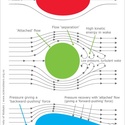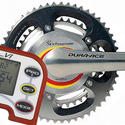In this activity, students measure speed and drag1 for a person on a bike to determine the effects of aerodynamic drag and rolling resistance on a cyclist’s maximum speed.
By the end of this activity, students should be able to:
- measure distance and time to calculate a cyclist’s maximum speed
- describe what might affect aerodynamic drag2 and rolling resistance
- experiment to find out how the maximum speed that a cyclist can reach is affected by different drag and rolling resistances
- measure the forces of drag and rolling resistance3 for a cyclist on a bike being pulled at a constant speed
- explain how forces need to be balanced for a cyclist to travel at a constant speed4.
Download the Word file (see link below) for:
- introduction/background notes
- what you need
- what to do
- extension ideas
- student worksheet.
Related content
Explore some of the main science ideas and concepts relating to this activity:
Activity idea
This activity is designed to help students develop a basic understanding of speed and acceleration5.
- drag: Sometimes called air resistance or fluid resistance, drag refers to forces that oppose the relative motion of an object through a fluid (a liquid or gas).
- aerodynamic drag: The force that acts against the motion of an object as it moves through the air. Also known as wind resistance or air resistance.
- rolling resistance: The force that opposes motion as a tyre (or other rolling object) rolls over the ground. Rolling resistance is caused as energy is converted into heat energy.
- constant speed: When the speed of an object such as a cyclist stays the same. If forces are balanced, the cyclist will travel at a constant speed.
- acceleration: The rate at which an object speeds up, slows down or changes direction.



